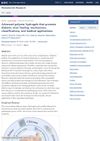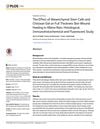Effects of Fibroblast Transplantation on Macrophage Content and Morphology of Regenerating Ischemic Cutaneous Wounds
December 2017
in “
International Journal of Biomedicine
”
TLDR Fibroblast transplantation improves wound healing, with dermal equivalents slightly enhancing skin regeneration.
The study conducted on 28 C57/B1 mice examined the effects of fibroblast transplantation on ischemic wound healing, focusing on macrophage content and tissue morphology. It was found that the introduction of autofibroblasts was most beneficial for regenerative histogenesis and inflammation. However, the transplantation of a dermal equivalent with heterofibroblasts resulted in the most differentiated epidermis, characterized by the formation of hair follicles. The differences in outcomes between the two methods were minimal, with the dermal equivalent showing slightly better results in terms of epidermis thickness (4.29%), collagen fiber area (2.66%), and blood vessel area (4.04%).



